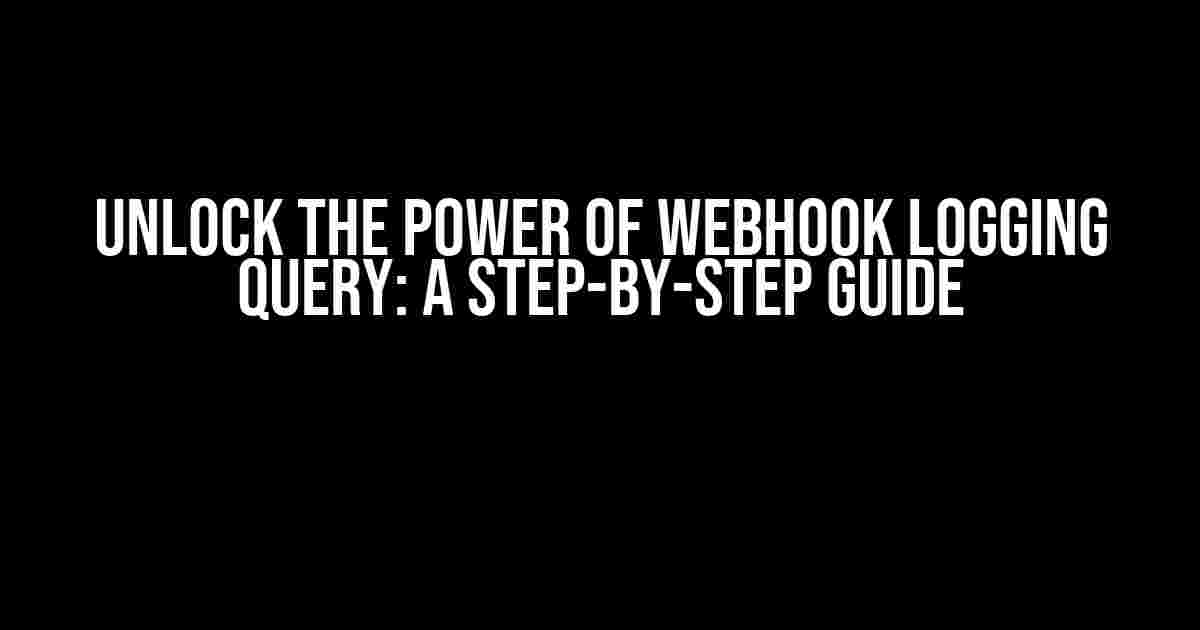Webhooks are a crucial part of any web-based application, allowing for seamless communication between systems. However, troubleshooting webhook-related issues can be a daunting task without the right tools and techniques. That’s where webhook logging query comes in – a powerful tool that helps you track, monitor, and analyze webhook activities. In this comprehensive guide, we’ll delve into the world of webhook logging query, exploring its benefits, setup, and implementation.
What is Webhook Logging Query?
Before we dive into the nitty-gritty, let’s define what webhook logging query is. A webhook logging query is a mechanism that allows you to retrieve and analyze log data related to webhook events. It’s a powerful tool for developers, DevOps teams, and system administrators to troubleshoot webhook-related issues, optimize webhook performance, and gain valuable insights into webhook activities.
Benefits of Webhook Logging Query
- Troubleshooting made easy: With webhook logging query, you can quickly identify and resolve webhook-related issues, reducing downtime and improving overall system reliability.
- Performance optimization: Analyze webhook performance metrics to identify bottlenecks and optimize webhook handling for improved system efficiency.
- enhanced security: Webhook logging query helps you detect and respond to potential security threats, ensuring the integrity of your system and data.
- Improved decision-making: Gain valuable insights into webhook activities to inform business decisions, optimize workflows, and improve overall system performance.
Setting Up Webhook Logging Query
Setting up webhook logging query requires some technical expertise, but don’t worry – we’ve got you covered! Here’s a step-by-step guide to get you started:
Step 1: Choose a Logging Tool
There are several logging tools available, including:
- ELK Stack (Elasticsearch, Logstash, Kibana)
- Splunk
- New Relic
- Google Cloud Logging
Choose a logging tool that aligns with your system requirements and expertise.
Step 2: Configure Logging
log4j.rootLogger=DEBUG, console, file
log4j.appender.console=org.apache.log4j.ConsoleAppender
log4j.appender.console.layout=org.apache.log4j.PatternLayout
log4j.appender.console.layout.ConversionPattern=%d{yyyy-MM-dd HH:mm:ss} [%t] %-5p %c{1}:%L - %m%n
log4j.appender.file=org.apache.log4j.FileAppender
log4j.appender.file.File=logs/webhook.log
log4j.appender.file.layout=org.apache.log4j.PatternLayout
log4j.appender.file.layout.ConversionPattern=%d{yyyy-MM-dd HH:mm:ss} [%t] %-5p %c{1}:%L - %m%n
In this example, we’re using Log4j to configure logging for a webhook application. The configuration specifies the logging level, console output, and file output.
Step 3: Send Webhook Logs to Logging Tool
Modify your webhook application to send logs to the chosen logging tool. This can be done using APIs, SDKs, or libraries provided by the logging tool. For example:
import logging
from logstash_formatter import LogstashFormatter
logger = logging.getLogger('webhook-logger')
logger.setLevel(logging.DEBUG)
logstash_handler = logging.handlers.SysLogHandler(address=('logstash-server', 5000))
logstash_handler.setFormatter(LogstashFormatter())
logger.addHandler(logstash_handler)
In this example, we’re using Python to send webhook logs to Logstash using the LogstashFormatter.
Querying Webhook Logs
Now that you’ve set up webhook logging query, it’s time to explore the world of querying webhook logs!
Basic Querying
Most logging tools provide a query language for retrieving log data. For example, in Elasticsearch, you can use the following query to retrieve all webhook logs:
GET /webhook-logs/_search
{
"query": {
"match_all": {}
}
}
This query retrieves all documents in the webhook-logs index.
Filtering and Aggregation
Filtering and aggregation enable you to narrow down log data to specific webhook events or metrics. For example, in Kibana, you can use the following query to retrieve webhook logs with a specific status code:
GET /webhook-logs/_search
{
"query": {
"term": {
"statusCode": 200
}
},
"aggs": {
"statusCode_count": {
"terms": {
"field": "statusCode"
}
}
}
}
This query retrieves webhook logs with a status code of 200 and aggregates the data by status code count.
Visualizing Webhook Logs
Visualizing webhook logs enables you to quickly identify trends, patterns, and anomalies. Most logging tools provide built-in visualization tools or integrate with third-party visualization platforms. For example, in Kibana, you can create a bar chart to visualize webhook response times:
| Time | Response Time (ms) |
|---|---|
| 2023-02-15 10:00:00 | 500 |
| 2023-02-15 10:01:00 | 300 |
| 2023-02-15 10:02:00 | 400 |
This visualization helps you identify spikes in response times, enabling you to optimize webhook performance.
Conclusion
Webhook logging query is a powerful tool for troubleshooting, optimizing, and analyzing webhook activities. By following this comprehensive guide, you’ve set up webhook logging query and learned the basics of querying webhook logs. Remember to explore your logging tool’s features, experiment with queries, and visualize your data to unlock the full potential of webhook logging query.
Happy logging!
Frequently Asked Question
Get all the answers you need to know about webhook logging queries!
What is a webhook logging query and why do I need it?
A webhook logging query is a powerful tool that helps you track and analyze webhook requests and responses in real-time. You need it because it provides valuable insights into your webhook integrations, enabling you to identify issues, optimize performance, and improve overall reliability.
How does a webhook logging query work?
A webhook logging query works by capturing and processing webhook requests and responses, storing them in a log, and making them searchable and analyzable. This allows you to write custom queries to extract specific data, set up alerts, and visualize your webhook activity in real-time.
What kind of data can I extract with a webhook logging query?
With a webhook logging query, you can extract a wide range of data, including request and response headers, bodies, and status codes, as well as metadata like timestamps, IP addresses, and user agents. You can also extract custom data points using our powerful filtering and parsing capabilities.
Can I set up alerts and notifications with a webhook logging query?
Yes, you can set up custom alerts and notifications based on specific conditions, such as error rates, response times, or data threshold breaches. This ensures that you’re always informed about critical issues and can take prompt action to resolve them.
Is a webhook logging query secure and compliant with data regulations?
Yes, our webhook logging query is built with security and compliance in mind. We implement robust data encryption, access controls, and auditing mechanisms to ensure the integrity and confidentiality of your data. We’re also compliant with major data regulations, such as GDPR and HIPAA.
